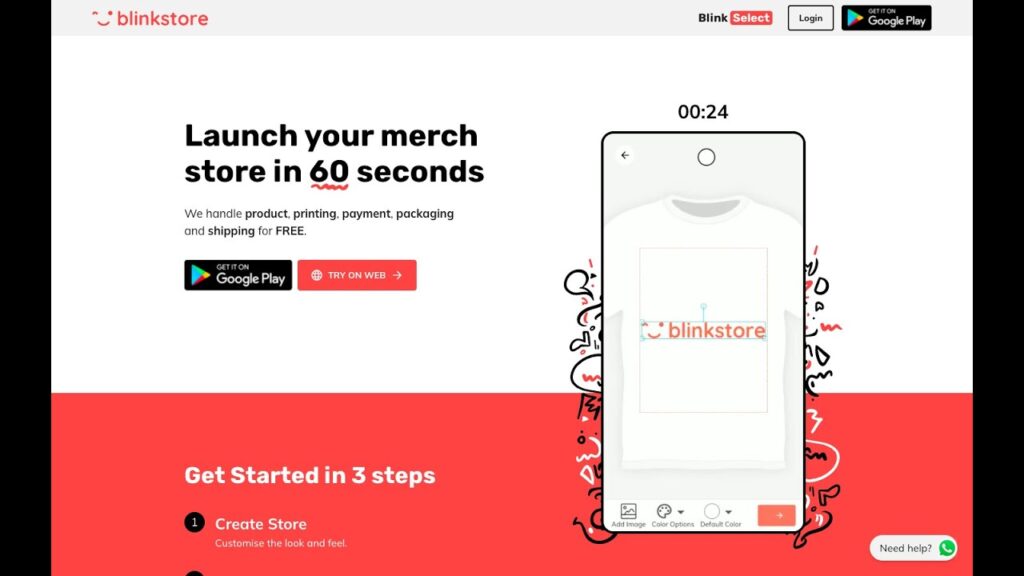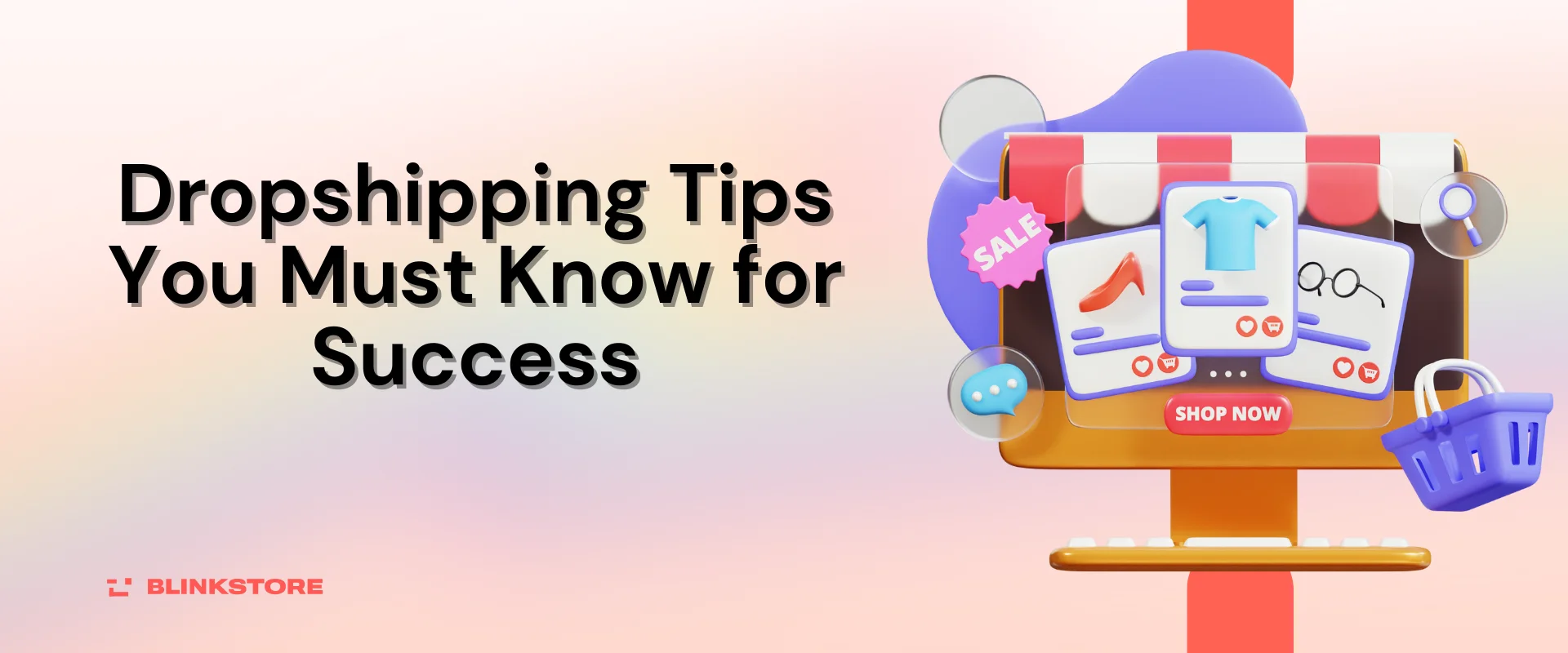Imagine someone else taking care of buying products upfront and handling all the shipping for you. That would make starting your business much easier. And you could work from anywhere. Well, It’s called dropshipping.
Dropshipping is getting more popular with new and experienced entrepreneurs starting online stores. You work with a trusted supplier who sends products directly to your customers.
About 23% of online sales use dropshipping, showing its potential. Also by 2030, it is anticipated that the dropshipping market will have expanded by 22.8% annually.
This blog will discuss effective dropshipping tips to help you be successful in online sales. These pointers will help you succeed in your dropshipping business and improve your tactics.
Table of Contents
23 Effective Dropshipping Tips for 2024
Dropshipping is evolving in 2024, offering new opportunities and challenges for online entrepreneurs. Here are some detailed dropshipping tips to boost your success in 2024:
1. Learn About Your Market

Knowing your target market and niche is crucial for dropshipping success. Learn about your customer’s preferences and shopping habits. Find what problems they want to solve. Then create your own dropshipping ideas. Use tools like Google Trends, SEMrush, or Ahrefs to spot trends. Study competitors, and learn what your customers like. Consider these dropshipping tips.
To discover what’s trending:
- Research your competition to understand their popular products.
- Explore social media platforms to observe what your target audience is purchasing or showing interest in.
- Utilize tools like Google Trends to identify products that are currently being searched for and purchased.
Example: If you’re selling fitness products, research shows more interest in home workout gear. Take advantage of this by offering unique and portable fitness items that fit this trend.
2. Use Data to Make Smart Choices
Make decisions based on data. Use tools like Google Analytics, Facebook Insights, or Shopify’s analytics to track sales. Find your best-selling products, and understand customer behavior.
This helps you pick the right products, improve marketing, and reach more customers. Gain data by creating mockups of products with mockup generators.
Example: Your sales data shows that yoga mats and resistance bands sell best. Focus on promoting these items and consider suggesting them together for more sales.
Dropshipping tips: Implement these fundamental Steps for Data Analytics:
- Collection: Begin by gathering data from diverse sources, including your ecommerce platform, social media channels, customer feedback, and other relevant sources.
- Processing: Organize and categorize the collected data systematically to facilitate interpretation. Data management tools can streamline this process, ensuring data is structured and accessible.
- Analyzing: Utilize analytical tools to interpret the data effectively. Identify patterns, trends, correlations, and valuable insights that can inform strategic decisions and improve business performance.
- Implementing: Translate insights derived from data analysis into actionable steps. Adjust strategies based on findings to enhance efficiency and maximize profitability. Regularly assess outcomes and refine approaches for continuous improvement.
3. Manage Your Inventory Effectively

Keep track of your inventory to avoid selling out or disappointing customers. Use software like TradeGecko, Inventory Source, or Ordoro to automate tracking and sync inventory across platforms. This ensures smooth order processing and reduces inventory problems.
Example: Using inventory management software lets you see stock levels in real time. You can set up alerts for low inventory to restock products before they run out.
Dropshipping Tips for Effective Inventory Management:
- Work with Different Suppliers: Use multiple suppliers to avoid relying on just one. This helps ensure you always have products available to sell.
- Choose Products Carefully: Pick products based on what sells well and which suppliers are reliable. This helps you manage your inventory more effectively.
- Use Versatile Products: Focus on items that can be sourced from different suppliers. This gives you flexibility in managing stock.
- Keep Track of Stock: Regularly check how much inventory your suppliers have. This helps prevent running out of products.
- Handle Out-of-Stock Situations: Be prepared for products that are out of stock. Offer alternatives or inform customers when items will be available again.
4. Plan Your Order Fulfillment Process
Streamline your order fulfillment to provide great customer service. Develop a clear process for processing orders, packing items, and shipping them quickly. Partner with reliable shipping companies to offer fast and affordable delivery options.
Effective Methods for Order Fulfillment has dropshipping tips:
- Direct Orders to Preferred Suppliers: Choose specific suppliers based on reliability, quality, or pricing preferences.
- Route Orders by Location: Send orders to suppliers closest to the customer to reduce shipping times and costs.
- Prioritize Orders Based on Availability: Fulfill orders with suppliers that have the required stock on hand to avoid delays.
- Optimize Order Routing by Price: Select suppliers offering competitive pricing to enhance profitability while meeting customer demand.
5. Keep Things Safe Online
Ensuring cybersecurity is paramount to safeguarding customer data and fostering trust in your dropshipping business. Implementing SSL certificates encrypts data transmitted between your website and users, providing a secure browsing experience. Playing cautious is always a dropshipping tips.
Additionally, secure payment gateways to protect financial transactions from fraud. Stay updated on cybersecurity best practices to mitigate risks and protect sensitive information.
Pro Tip: Regularly conduct security audits to identify vulnerabilities and address them promptly. A recent survey suggests, online consumers are concerned about their security when making online purchases.
6. Deal with Payment Issues

Addressing payment disputes is essential to maintaining positive customer relationships and reducing chargebacks. Offer a variety of payment methods to accommodate.
Streamline the dispute resolution process by offering clear instructions and responsive communication to resolve issues efficiently.
Pro Tip: Use automated tools like Chargehound or Stripe Radar to identify and prevent potential payment disputes before they escalate, minimizing disruptions to your business.
7. Give Really Good Help to Customers
Delivering exceptional customer support is crucial for building loyalty and satisfaction. Offer support through various channels such as live chat, email, or social media platforms.
Ensure prompt responses to inquiries and concerns, demonstrating a commitment to customer care. Implementing a knowledge base or FAQ section on your website can empower customers to find answers independently, enhancing their overall experience.
Pro Tip: Use customer support analytics to identify common issues and improve response times. According to industry data, 78% of consumers have bailed on a transaction due to poor service.
8. Think About Using the Phone for Help
Consider incorporating phone support to provide personalized assistance, especially for complex issues or high-value transactions.
Offering direct communication via phone can enhance trust and resolve customer concerns efficiently. Implement call tracking to monitor customer interactions and gather insights for improving service quality.
Pro Tip: Customers prefer to resolve their issues by speaking with a live agent. Use call recording software to review customer interactions and train support staff.
9. Use Good Ways to Tell People About Your Products

To make sure more people know about your dropshipping products, use these dropshipping tips:
- Write Good Descriptions: When describing your products, focus on what makes them special. Talk about their features, benefits, and how customers can use them. Use clear and engaging language to catch people’s attention.
- Use Great Pictures: Show off your products with high-quality images. Good photos can make customers feel confident about buying from you. Use professional photography to highlight details and make your products look appealing.
- Persuade with Marketing: Use persuasive tactics like limited-time offers, customer reviews, and social proof to convince people to buy. Limited-time deals create urgency, positive reviews build trust, and social proof shows that others like your products.
- Pro Tip: Use tools like Google Keyword Planner or SEMrush to find popular keywords. Incorporate these keywords into your descriptions and marketing to help more people find your products online.
10. Pick a Supplier You can Trust

Picking the right supplier is crucial for your dropshipping business to succeed. Look for suppliers with quality products, fair prices, and reliable shipping.
Pro Tip: Use supplier directories like Alibaba, SaleHoo, or Oberlo to find reputable suppliers with positive reviews and a history of good service.
Fix any problems with your supplier
Keep communication open with your suppliers to solve problems fast. Address issues like product quality, shipping delays, or communication gaps right away. Clear communication and finding solutions together will keep your business running smoothly.
Pro Tip: Track your supplier’s performance with metrics like on-time delivery and product quality. This helps you spot areas for improvement and ensures consistent service.
11. Try Out Samples Before You Buy in Bulk
Before placing large orders, test product samples to check quality, packaging, and delivery times. This helps you avoid problems and choose the best products for your customers. Negotiate discounts with suppliers for samples to save costs.
Pro Tip: According to industry data, businesses that test samples before ordering in bulk have fewer returns and happier customers.
12. Make Your Brand Stand Out

Creating a distinctive brand identity is crucial in the dropshipping. Look dropshipping tips below:
- Compelling Storytelling: Create a story that is distinct and appeals to your intended audience. Share the story behind your brand, its mission, and values to build emotional connections.
Example: If you’re dropshipping eco-friendly products, highlight your commitment to sustainability and environmental impact reduction.
- Distinctive Visuals: Invest in eye-catching visuals, including logos, colors, and imagery, that reflect your brand’s personality. Having a consistent brand across all channels improves recognition.
- Memorable Customer Experiences: Prioritize providing outstanding customer service and customized encounters. Engage with customers on social media, respond promptly to inquiries, and exceed expectations with every interaction.
- Pro Tip: Use tools like Canva or Adobe Spark to create professional-looking visuals for your brand without extensive design skills. You can check our blog on improving brand sense.
13. Pick the Best Way to Sell Your Products
Selecting the appropriate sales channel is an essential tips dropship successfully in the target market. Here are considerations for selecting the best platform:
- Evaluate Platform Options: Compare e-commerce platforms such as Blinkstore, WooCommerce, or Etsy.
- Audience Fit: Identify where your target audience spends their time online. Opt for platforms that attract your demographic to maximize visibility and sales.
- Pro Tip: Utilize Google Analytics to understand your website traffic and demographics, helping you make informed platform decisions.
14. Set Fair Prices That People Will Like

Determining competitive yet profitable pricing is essential for customer acquisition and retention. Here’s how to establish appealing price points with these dropshipping tips:
- Competitive Research: Analyze competitors’ pricing strategies and market trends to gauge appropriate price ranges.
Example: Research similar products on other dropshipping sites and identify price trends to set competitive rates.
- Transparent Pricing: Clearly communicate your pricing structure, including shipping costs and promotions, to build trust with customers.
- Pro Tip: Use pricing tools like Price2Spy or Competitor Monitor to monitor competitor pricing and adjust your strategy accordingly.
15. Make Your Product Pages Look Good Online
Optimizing product pages enhances user experience and boosts conversions. Use these dropshipping tips to write product pages that are engaging:
- Engaging Content: Write clear and detailed product descriptions that highlight features, benefits, and unique selling points. Make effective use of images and bullet points when communicating information.
Example: Include customer reviews and testimonials to build credibility and trust.
- User-Friendly Navigation: Ensure seamless navigation with intuitive menus, search functionality, and filters to help customers find products easily.
- Persuasive Calls-to-Action: Use compelling CTAs to encourage action, such as “Buy Now” or “Add to Cart.” Place CTAs strategically throughout the page for maximum impact.
- Pro Tip: Implement A/B testing with tools like Google Optimize to optimize product page elements for improved conversion rates.
16. Make Your Rules Easy to Understand
Clarity in your business policies is essential for customer trust and satisfaction. Consider the following dropshipping tips:
- Simplified Language: Use straightforward and jargon-free language in your policies to ensure they are easily comprehensible to customers.
- Visual Aids: Incorporate visual elements such as infographics or flowcharts to illustrate key policies, making them more engaging and digestible.
- Pro Tip: Use online tools like Canva or Piktochart to create visually appealing policy summaries.
Be Clear About Your Rules for Shipping and Returns

Transparent communication of shipping and return policies is crucial for managing customer expectations. Implement the following dropshipping tips:
- Prominent Display: Showcase shipping timelines and return conditions prominently on your website, ideally on product pages and checkout screens.
- Policy Details: Provide comprehensive information about shipping methods, costs, and return procedures to address common queries upfront.
Example: Clearly state “Estimated Delivery: 3-5 Business Days” and “30-Day Return Policy” on product descriptions.
- Pro Tip: Use customer feedback to refine your policies and address pain points in the shipping and returns process.
Have a Clear Plan for Returns
Simplify the returns process to enhance customer satisfaction and minimize disputes. Consider the following dropshipping tips:
- Hassle-Free Policies: Offer straightforward return policies with minimal conditions or restocking fees to encourage customer confidence.
- Clear Instructions: Provide step-by-step instructions for initiating returns and processing refunds, ensuring customers know what to expect.
Example: Provide a prepaid return shipping label for easy returns.
- Pro Tip: Leverage customer service tools like Zendesk or Freshdesk to streamline return requests and automate responses.
17. Make Purchasing from Your Website Simple for Visitors

Optimize website usability and checkout processes to reduce friction and improve conversion rates. Implement the following dropshipping tips:
- User-Friendly Navigation: Ensure intuitive website navigation with clear categories, search functionality, and product filters.
- Streamlined Checkout: Simplify the checkout process with guest checkout options, autofill features, and progress indicators to guide customers through each step.
Example: Offer multiple payment options (e.g., credit card, PayPal) and save shipping addresses for returning customers.
- Pro Tip: Use tools like Hotjar or Google Analytics to analyze user behavior and identify potential bottlenecks in the checkout process for optimization.
18. Using Technology for Better Orders
To make managing orders easier and faster, use tools that automate tasks:
- Order Automation: Try using systems like Zapier or ShipStation to handle orders automatically. This reduces mistakes and saves time.
- Inventory Management: Use software like TradeGecko or Skubana to track what you have in stock. This helps prevent selling items you don’t have.
- Pro Tip: Connect your inventory software to your dropshipping platform for smoother operations.
19. Getting the Word Out About Your Business
Reach more customers by using digital marketing. Here are some dropshipping marketing tips:
Use Search Engine Optimization SEO. This improves your website’s visibility by using the right keywords and tags. Write blog posts about popular topics in your field, using important keywords.

Do ads on platforms like Facebook, Instagram, or TikTok to find more customers. Partner with popular people in your field to promote your products and get more attention.
Choose a unique name for your brand
Give your company a good dropshipping name that has to mean for your target audience to help it stand out: Choose a name that reflects your values and the core principles of your company.
Example: If you care about the environment, include words related to sustainability in your brand name.
20. Choosing the Best Place to Sell Online
To find the perfect online platform for your business, consider these dropshipping tips:
- Research Platforms: Look into different e-commerce websites and online marketplaces to see which ones match your niche and goals the best.
- Evaluate Features: Compare the features and tools each platform offers, such as payment options, shipping integrations, and customer support.
- Consider Fees: Check the fees associated with each platform, including listing fees, transaction fees, and subscription costs.
21. Creating Engaging and Quality Content

Boost customer interest by creating useful and interesting content:
- Blogs: Write blog posts about topics related to your products or industry. A website’s visibility can be increased by using keywords.
Example: If you sell fitness equipment, write articles about workout routines or healthy living tips.
- Videos: Make videos showcasing your products or providing tutorials. Videos can be more engaging and help customers understand your offerings better.
- Tutorials: Create instructional guides or how-to articles that demonstrate the benefits of your products. Use video editing tools like Canva or Adobe Premiere Rush to create professional-looking videos.
22. Leveraging Seasonal Products and Promotions
Maximize sales by capitalizing on seasonal trends and holidays. Offer products that match seasonal demands, such as summer clothing or holiday decorations.
During the back-to-school season, promote items like backpacks or school supplies. Create special discounts or promotions for holidays or seasonal events to attract more customers.
23. Consider Branded Dropshipping

Branded dropshipping adds value by allowing you to sell products under your own brand name, enhancing customer trust and loyalty. These tips can help you implement branded dropshipping effectively in your online business.
- Choose Quality Suppliers: Opt for suppliers who offer customization options like private labeling or custom packaging.
- Create a Strong Brand Identity: Develop a cohesive brand identity that includes a logo, color scheme, and brand voice aligned with your values and appealing to your target audience.
- Customize Product Packaging: Invest in custom packaging that showcases your brand and provides a memorable unboxing experience for customers.
Dropshipping challenges you should tackle
Although dropshipping has many advantages, it also has a unique set of difficulties. Here are some common challenges that dropshippers face and strategies to tackle them effectively:
Supplier Reliability
- Challenge: Depending on third-party suppliers means you’re reliant on their inventory management, shipping times, and product quality.
- Strategy: Thoroughly research and vet suppliers before committing. Look for suppliers with good reviews, clear communication, and reliable shipping practices.
Inventory Management
- Challenge: Keeping track of inventory across multiple suppliers and platforms can lead to overselling or stockouts.
- Strategy: Use inventory management tools that sync across platforms to automate stock updates and prevent issues with availability.
Shipping Times and Costs
- Challenge: Slow shipping times and high shipping costs can lead to customer dissatisfaction.
- Strategy: Choose suppliers with efficient shipping processes and consider using multiple suppliers strategically to balance costs and delivery times.
Quality Control
- Challenge: You don’t have direct control over product quality and packaging.
- Strategy: Order samples before committing to bulk orders to assess product quality. Communicate quality standards clearly with suppliers.
Customer Service
- Challenge: Handling customer inquiries, returns, and complaints can be challenging without physical control over products.
- Strategy: Provide exceptional customer service through multiple channels (email, live chat) and have clear policies for returns and refunds.
Profit Margins
- Challenge: Competing on price while maintaining profitability can be tough.
- Strategy: Focus on niche products with higher profit margins. Consider upselling or offering complementary products to increase average order value.
Start a Successful Dropshipping Business with Blinkstore

Easy Signup
Join Blinkstore by signing up with your Google account or entering your email address manually. With Blinkstore you can start a free dropshipping business without any cost.
Store Name and Branding
Click on “Create Store” to choose a name for your store or dropshipping business. Customize it with your branding and connect it to your custom domain.
Make Your Products and Sell
Select products from Blinkstore’s print-on-demand catalog and upload your designs. List them on your store to start selling across India at your chosen profit margins. Your earnings from a sale can be withdrawn to your bank account by visiting the payout section.
Conclusion
In the online business world, dropshipping is a great way to start with low risk and high rewards. You are relieved of the burden of maintaining inventory levels and handling product shipping.
Follow these effective dropshipping tips to handle challenges and succeed in dropshipping. Use market research, data-driven decisions, and customer-focused strategies to thrive in 2024 and beyond. Start your dropshipping business now and discover the potential of this exciting business model!
FAQs on Dropshipping Tips
Here are some frequently asked questions in Dropshipping Tips.
How to Successfully Dropship?
To succeed in dropshipping, focus on finding reliable suppliers, selecting trending products, optimizing your online store, and providing excellent customer service.
How Can a Beginner Start Dropshipping?
Beginners can start dropshipping by choosing a niche, setting up an online store using platforms like Blinkstore, sourcing products from suppliers, and promoting their store through marketing strategies.
What Sells Well on Dropshipping?
Products that sell well in dropshipping often include fashion accessories, tech gadgets, home decor items, and fitness equipment. Research trending products and identify niche markets for potential success.
Is Dropshipping Worth It for Beginners?
Dropshipping can be worth it for beginners due to its low startup costs, minimal inventory management, and flexible work arrangements. Success largely depends on effective product selection and marketing strategies.
Do I Need GST for Dropshipping?
If dropshippers’ yearly turnover surpasses the government-imposed threshold, they must register for Goods and Services Tax (GST).
Is Dropshipping Legal in India?
Yes, dropshipping is legal in India. However, dropshippers must comply with tax regulations, intellectual property laws, and consumer protection guidelines applicable to e-commerce businesses.
